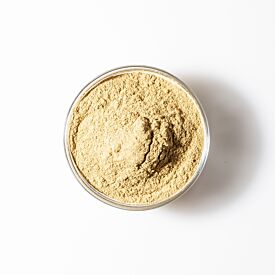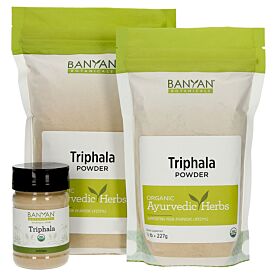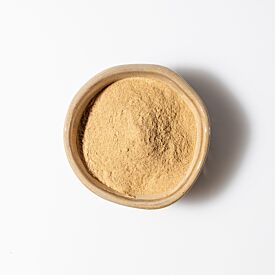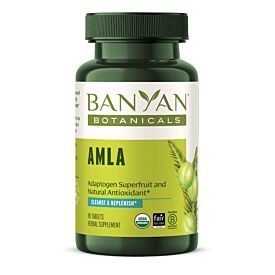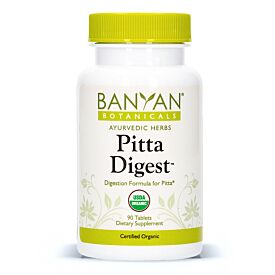The Benefits of Amalaki (Amla)
Amalaki (Emblica officinalis), also known as amla, is a potent rejuvenating herbal adaptogen, renowned for its impressive list of health benefits and all-encompassing support. A longtime go-to herb for its many benefits, it has been used in Ayurveda and other Asian medicinal practices for thousands of years.1
Offering a high concentration of natural antioxidants and vitamin C, amalaki is a powerful ally for strengthening the immune system, nourishing the tissues, and gently removing toxins.2
But that’s just the beginning—the wondrous healing properties of this little green fruit extend throughout the entire physiology, supporting the body from head to toe, gut to brain, skin to teeth to hair—and beyond!
In this article:
- What Is Amla? Characteristics of the Amalaki Tree
- Amalaki or Amla Benefits and Uses
- How to Take Amalaki
- Modern Research on Amalaki
- Is Amalaki Safe?
- The Growing and Harvesting of Banyan’s Amalaki
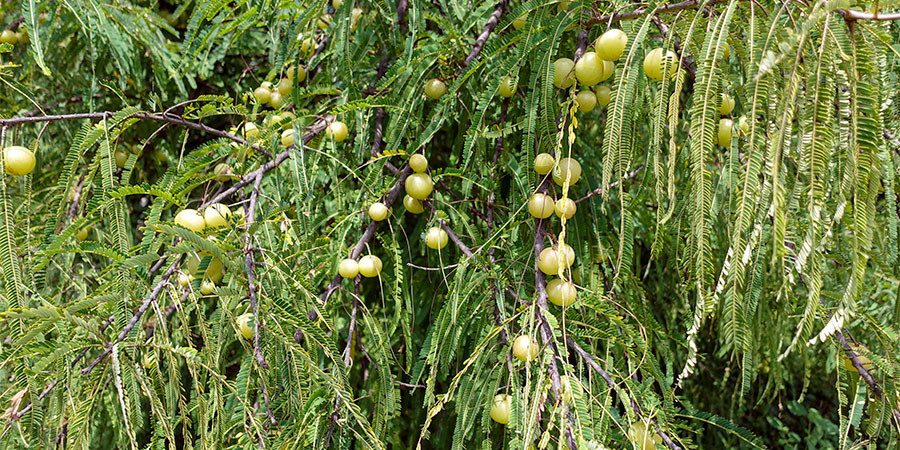
What Is Amla? Characteristics of the Amalaki Tree
Despite amla’s incredible renown, especially in the world of Ayurveda, it’s not something that we encounter on a regular basis here in the US. Unless there’s an Indian market in your neighborhood, you likely won’t find these fruits at your local grocery store.
Amalaki is the Sanskrit name for the Indian gooseberry tree (Emblica officinalis or Phyllanthus emblica) that grows throughout India and bears small, sour-tasting fruits.3
The flowers eventually develop into small, green, edible fruits that are somewhat fibrous and surprisingly sour.4 In fact, the sour taste is such a prominent feature of the fruit that it inspired the name amla, which literally means “sour” in Hindi.
Other Sanskrit nicknames for amalaki—names meaning “mother,” “nurse,” and “immortality”—are a testament to the power of this medicinal plant and the healing capacity of its fruits.5,6
Considering just how sour it is, you may be wondering, is amla a citrus fruit? Or is amla an herb?
Starting with the former question: amalaki is indeed considered an herb in Ayurveda. And while amla is sometimes called a citrus thanks to its taste and its high content of vitamin C, it is in a different family. Citrus is a genus of plants belonging to the rue family (Rutaceae), while amalaki belongs to Phillanthaseae, and the amalaki fruits don't have the thick, fleshy skin characteristic of citrus plants.7
Are There Vitamins in Amla?
Amalaki is popularly known to be a natural source of antioxidants due to its rich phytochemistry with the presence of ascorbic acid (vitamin C) and polyphenol content.8
Some sources even suggest the small, tart amalaki fruit has one of the highest known concentrations of vitamin C in the plant kingdom.9 Even more importantly, the vitamin C naturally found within the amalaki fruit is stabilized by the presence of tannins, which help to maintain the vitamin content even through processing.10
Beyond its antioxidant activity, the polyphenol content, especially tannins, a key group of phenolic compounds found in amla fruits, further contributes to amalaki's effectiveness in supporting a healthy digestive tract and the body's natural cleansing process.11
Amla is also an excellent source of vitamin A and vitamin E, as well as iron, calcium, and dietary fiber.12
While the tart fruits can be eaten fresh or used in cooking, most versions of an amalaki supplement on the market today are made from fruit that has been dried and powdered.
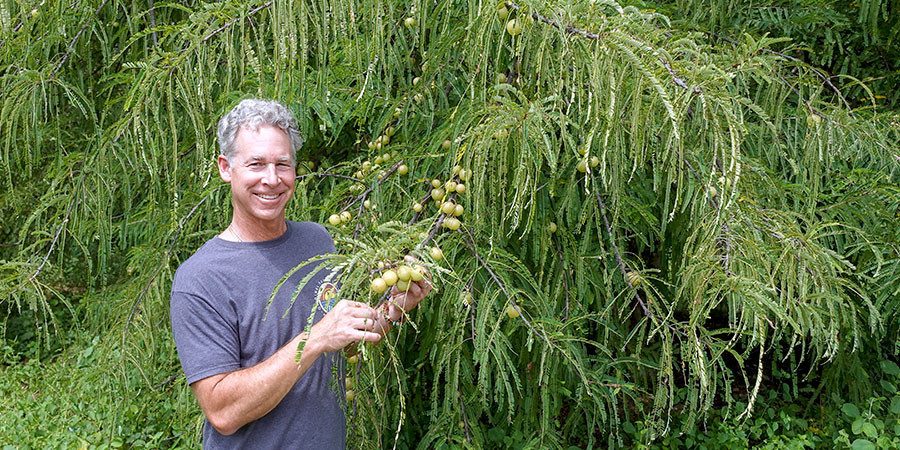
Amalaki or Amla Benefits and Uses
Amalaki’s deeply rejuvenating properties, along with its high concentration of antioxidants and vitamin C, make it incredibly supportive for the entire body. It is known to strengthen the immune system, support healthy digestion and elimination, and enhance longevity, among many other benefits.13
Here are some of the remarkable ways amalaki benefits the body:
- Fosters a healthy immune system: Highly nourishing and rejuvenating to the tissues, amalaki supports robust health in the entire physiology. It cultivates youthfulness, bolsters a healthy immune system, and promotes overall health and well-being.14
- Enhances digestive health: Amalaki’s potent sour taste is known to activate and support digestion, helping the body to easily digest, absorb, and assimilate nutrients. It also cleanses and protects the liver, which plays a critical role in transforming food into physiologically useful nourishment.15
- Promotes proper elimination: Thanks to its high antioxidant content and cleansing nature, amalaki supports natural detoxification in the GI tract and throughout the body. It also soothes, tones, and rejuvenates the bowels, supporting proper and regular elimination of toxins.16
- Maintains healthy blood sugar levels: Amalaki’s ability to stimulate microcirculation and cleanse the blood help to promote healthy blood sugar levels already in the normal range. It also has an affinity for the urinary tract and the healthy excretion of urine, which goes hand in hand with balanced blood sugar levels.17
- Strengthens the bones, teeth, and nails: Its tonifying and rejuvenating properties help strengthen the entire body, but it is known to have a special affinity for building strong and healthy bones, teeth, and nails.
- Fosters thick, healthy hair: Amla is revered for its ability to nourish and rejuvenate the health of the hair, leading to full, lustrous, shining locks—especially when it is used in a hair oil.
- Nourishes the heart and respiratory system: Amalaki helps promote healthy circulation, tonify the muscle of the heart, and support the health of the lungs.
- Calms the mind and emotions: Considered a brain tonic, amalaki supports a clear mind and enhances memory. It has a sattvic nature that fosters subtle awareness, balances emotions, and brings a sense of calm to the mind.18
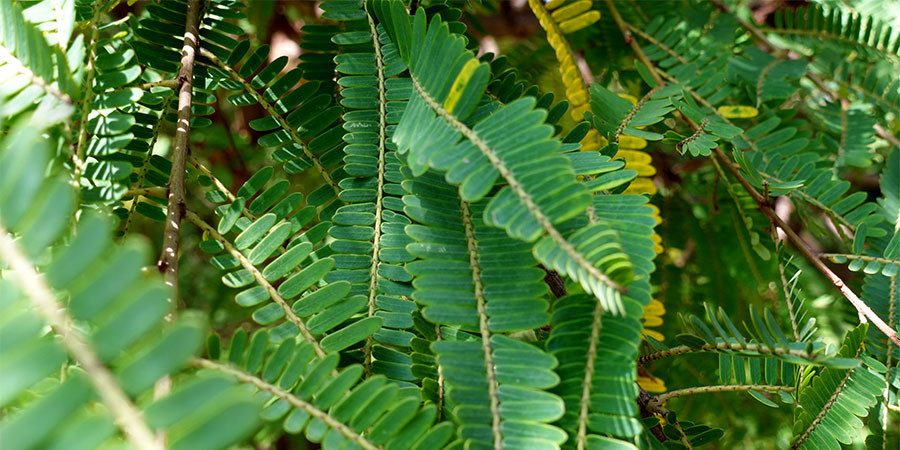
Amalaki in Ayurveda
Amalaki has been renowned in the Ayurvedic tradition for thousands of years. It is known to pacify all three doshas of vata, pitta, and kapha, though it is especially calming to pitta.19
In Ayurveda’s language of energetics, amalaki is said to have a rasa (taste) that is primarily sour, as well as sweet, pungent, bitter, and astringent. Its virya (action) is cooling, and its vipaka (post-digestive effect) is sweet.
From an Ayurvedic perspective, digestion begins with the experience of taste. Because amalaki contains five of the six tastes, lacking only the salty taste, it stimulates digestion, improves appetite, and kindles agni (the digestive fire).
Despite the fact that its predominant taste is sour, which can be aggravating to pitta-type digestion, amalaki stokes the digestive fire without causing harm or imbalance to pitta. In fact, it is particularly suited to clearing excess pitta from the digestive tract, thanks to its bitter taste and cooling nature.
Even as it clears and detoxifies the system, amalaki is known as a rasayana herb, renowned for its deeply rejuvenating and nourishing properties throughout the body. This makes it a powerful contributor to the formation of ojas, the body’s essential reserve of immunity and youthfulness.20
How to Take Amalaki
Because of amalaki’s many uses and benefits, there are countless ways that it can be used—both internally and externally—to support thriving health.
Taking Amalaki powder mixed with warm water or another anupan (carrier substance) such as milk, honey, or ghee, is one of the most traditional methods of consumption.
Banyan also offers Amalaki tablets as a convenient option. The tablets are a nice alternative for those who find the taste a deterrent to taking herbs.
Here are a few other ideas for taking amalaki to support specific areas of health.
Amla for Healthy Digestion and Elimination
Triphala. Triphala literally means “three fruits” and includes amalaki, bibhitaki, and haritaki. Triphala is the most widely used formula in Ayurveda. Like amalaki, it is deeply nourishing and cleansing to all tissues and primarily used to maintain a healthy digestive tract. If there are clear signs of excess heat and pitta in the digestive tract, amalaki taken alone may prove more supportive than triphala.
Pitta Digest. Amalaki is well-known for its cooling and soothing effect on the GI tract, especially when the excess heat of pitta dosha is creating digestive disturbance. Pitta Digest tablets help to maintain healthy digestive acid levels and support a comfortable post-meal experience.
Total Body Cleanse. Amalaki is featured as the main ingredient in Total Body Cleanse, accompanied by other Ayurvedic herbs known to assist the body’s natural detoxifying process. This product can be used during an Ayurvedic cleanse, or as a daily supplement for gentle, ongoing support.
Immune and Respiratory Health
Chyavanprash. Chyavanprash is a traditional nutritive Ayurvedic jam, primarily aimed at bolstering the immune system, rejuvenating the tissues, and building ojas. It is made with a base of amalaki fruit and also includes a number of other herbs, ghee, sesame oil, sugar, and honey.21
Immune Health Now. Packed with some of the most powerful herbs in the Ayurvedic pharmacopeia, amalaki included, Immune Health NOW bolsters the body’s immune defenses, supports healthy lungs, and supports a healthy respiratory tract.
Pollen Protect. The perfect herbal ally for seasonal shifts, Pollen Protect tablets support a healthy response to seasonal irritants and promote respiratory health.
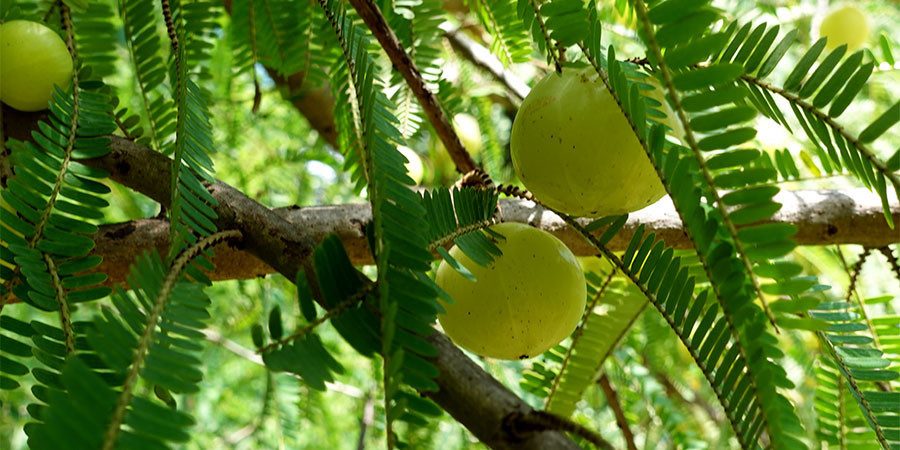
Amla for Healthy and Lustrous Hair
Healthy Hair. In Ayurveda, the health of the hair can be compromised by an excess of pitta, or too much heat in the body. Amalaki’s cooling and soothing properties are featured in our Healthy Hair tablets to support a strong, healthy, lustrous head of hair.
Healthy Hair Oil. Healthy Hair Oil is an herbal massage oil for the hair and scalp, designed to support the health, growth, and luster of the hair. In this formula, amalaki joins forces with other herbs known to support healthy hair and a calm mind, including bhringaraj, brahmi/gotu kola, and hibiscus.
Amla for Oral Care
Tooth Powder. Our Tooth Powder, available in two delicious flavors, combines amalaki with other powerful herbs and minerals to leave the teeth and mouth feeling clean and refreshed. It also includes activated charcoal made from dried amalaki to support cleansing and detoxification.
Daily Swish. The practice of oil pulling is an excellent way to support the health and hygiene of the teeth, mouth, and gums. Banyan’s Daily Swish is made from a base of sesame and coconut oil and infused with herbs that support oral health—amalaki included!
Amla for Bone and Joint Health
Joint Support. Our Joint Support tablets combine amalaki with other detoxifying and rejuvenating herbs in a formula that is targeted at maintaining the comfortable, healthy function of the joints and muscles.
Joint Balm. Amalaki’s detoxifying properties are joined by guggulu, boswellia, and several other cleansing and rejuvenating herbs to create this soothing, nourishing Joint Balm. This penetrates deeply into the tissues of the joints and muscles to promote comfort and healthy, easeful movement.
Amla for Whole Body Health
Elevated Adaptogens. Give your whole body a boost with Elevated Adaptogens. This powdered blend of adaptogens and superfoods combines amalaki with turmeric, ashwagandha, eleuthero, and others to create a formula that rejuvenates the entire body.

Modern Research on Amalaki
There has been significant scientific research evaluating the benefits of amalaki, both on its own and as an ingredient in chyavanprash and triphala. Below are a few recent studies that summarize some of these findings:
- “Clinical Evaluation of Emblica Officinalis Gatertn (Amla) in Healthy Human Subjects: Health Benefits and Safety Results from a Randomized, Double-blind, Crossover Placebo-controlled Study.” PubMed Abstract. 2019.22
- “Exploring the Multifaceted Neuroprotective Actions of Emblica officinalis (Amla).” PubMed Abstract. 2019.23
- “Emblica officinalis (Amla): A Review for its Phytochemistry, Ethnomedicinal Uses and Medicinal Potentials.” PubMed Abstract. 2016.24
- “Chyawanprash: A Traditional Indian Bioactive Health Supplement.” PubMed Abstract. 2019.25
- “Therapeutic Uses of Triphala in Ayurvedic Medicine.” PubMed Abstract. 2017.26
Is Amalaki Safe?
Amalaki is a rejuvenating, adaptogenic herb that is generally considered safe for all doshas and is especially beneficial for pitta. That said, there are a couple of instances in which it’s best to exercise caution.
Contraindications
Amla should be avoided in cases of high ama or when kapha is especially aggravated.27 There is some evidence to suggest caution among individuals with an iron deficiency because amalaki can form chelates with iron and thus reduce the amount of usable iron in the blood.28
For those who are pregnant, nursing, or taking medications, we recommend speaking to your doctor or Ayurvedic practitioner before taking amalaki.

The Growing and Harvesting of Banyan’s Amalaki
Banyan’s amalaki is grown in the semi-arid regions of Gujarat and Rajasthan in Northern India. The amalaki trees are cultivated from young saplings and need careful tending for the first four years to reach maturity and begin bearing fruit. After the first four years, they are robust and healthy enough to thrive on their own.
To harvest the amalaki fruit, a bamboo ladder is set up on a trunk of tree with one person plucking the fruits directly from the tree and the other person gathering the harvest in a cane basket. Or in some cases, a fine mesh net is used to gather the ripe fruits that fall from the tree.
Sustainability of Amalaki
Because our amalaki is cultivated, there are no issues with overharvesting or sustainability concerns.
As a part of a larger conversation regarding the sustainability of Ayurvedic herbs, it is important to understand where and how plants are grown and harvested when you’re considering where to buy amla.
We ensure sustainability by sourcing the botanicals used in our products from privately owned farms where each plant has been cultivated or harvested from legal wild-craft sourcing. Our herbs and ingredient-producing plants are harvested at optimal times, using environmentally sustainable practices sensitive to the long-term health of the plants.


